Eduard 1/48 Morane-Saulnier Type N
|
KIT #: |
8090 |
|
PRICE: |
$25.00 or so MSRP |
|
DECALS: |
Two options |
|
REVIEWER: |
Pierre-André Boillat |
|
NOTES: |
Improved
new mold issued in 2004 |
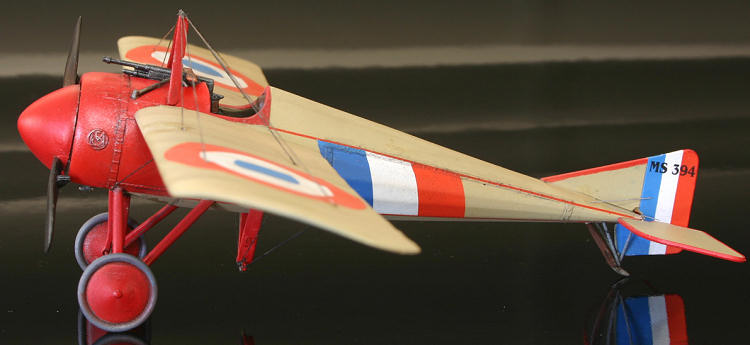
The
Morane-Saulnier Type N was the first purpose-built fighter aircraft, and
although only 49 were produced and saw active service for a short time, it
deserves an important place in aviation history.
Designed
by aviation pioneers Léon Morane (a pilot with flying license #54 issued by the
Aéro Club de France) and Louis Saulnier (an engineer who had worked on Louis
Blériot’s Channel-crossing Type XI), the Type N was a nimble fighter monoplane
powered by a Le Rhône 9C rad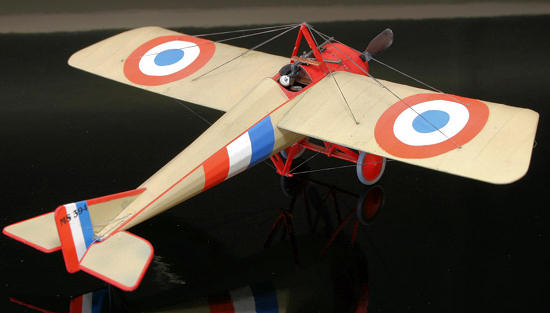 ial
engine of 110HP for a weight of 510 Kg, which allowed it to reach a top speed of
165 KmH and a maximal altitude of 4’000 M.
ial
engine of 110HP for a weight of 510 Kg, which allowed it to reach a top speed of
165 KmH and a maximal altitude of 4’000 M.
The
most notable feature of the type was its single Hotchkiss 7.9mm machine-gun
firing through the propeller arc, the prop blades being protected by two steel
deflectors. This early system pre-dating synchronized weapons had been invented
and successfully used in combat by the famous pilot Roland Garros on a
parasol-winged Morane-Saulnier Type L (and not an N as it’s commonly believed).
The
Type N entered service with the French Air Force in April 1915 in
France’s
very first fighter squadron, Escadrille M.S.12 under Captain de Bernis. It also
equipped three Royal Flying Corps squadrons (the type being named “Bullet” by
the British), and a few served with
Russia’s
19th squadron.
With
its early wing-warping system instead of ailerons and high landing speed, the
Type N wasn’t an easy plane to fly and didn’t prove very popular with its users.
However, it performed rather well at the hands of a skilled pilot, like
daredevil Jean Navarre, who would later become famous as “The Sentinel of
Verdun”.
As technical progress advanced at great speed in these days of war, the
Morane-Saulnier N quickly became obsolete and was withdrawn from frontline
service after a short time.
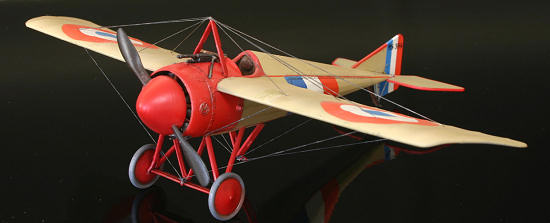 This
model from 2004 is the second Morane-Saulnier Type N produced by Eduard. It was
a welcome replacement for the first one, which was one of the brand’s most early
(and rather crude) kits. All photo-etched and white metal parts have been
replaced by (superior) injected ones, the main plastic parts being reworked. Due
to the type’s simple design, there are not many parts, and the kit assembles
rather quickly. Two decal options are provided, for French machines (one with a
black nose that may be
Navarre’s
aircraft, and the subject of this review, with more colourful markings). Also,
you get a set of “express masks” for the tail plane fillets and wheels (fillets
are found on the decal sheet, too, if you don’t want to mask). A Lewis
machine-gun is included, which allows to build a British “Bullet” (if you have
decals).
This
model from 2004 is the second Morane-Saulnier Type N produced by Eduard. It was
a welcome replacement for the first one, which was one of the brand’s most early
(and rather crude) kits. All photo-etched and white metal parts have been
replaced by (superior) injected ones, the main plastic parts being reworked. Due
to the type’s simple design, there are not many parts, and the kit assembles
rather quickly. Two decal options are provided, for French machines (one with a
black nose that may be
Navarre’s
aircraft, and the subject of this review, with more colourful markings). Also,
you get a set of “express masks” for the tail plane fillets and wheels (fillets
are found on the decal sheet, too, if you don’t want to mask). A Lewis
machine-gun is included, which allows to build a British “Bullet” (if you have
decals).
Due to
the fragile nature of WWI planes, I decided to work in sub-assemblies. The few
cockpit parts (decals are provided for the few instruments) are quickly put
together (I only added masking tape seat belts), the engine, cowling and the
cover in front of the cockpit being added to the small fuselage. Afterwards, all
elements were pre-painted. The express masks come quite handy,
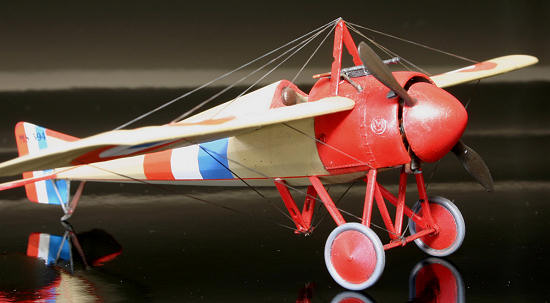 especially
on the tail planes. After a gloss coat, I added the decals (the red fillets on
the fuselage are a bit tricky to get right) and allowed them to dry for 24
hours. At this moment, I drilled little holes in the wings for the final
rigging.
especially
on the tail planes. After a gloss coat, I added the decals (the red fillets on
the fuselage are a bit tricky to get right) and allowed them to dry for 24
hours. At this moment, I drilled little holes in the wings for the final
rigging.
All the
parts being ready and painted, I then started the final assembly. Here, two
things must be said: the locating holes for the landing gear struts are too
small/too shallow and have to be drilled out, and the “V” struts supporting the
tail skid are too short and touch the rudder – I had to make a new set from
stretched sprue - no big deal. Besides this, I had lost one the struts that
support the rigging/wing-warping cables under the fuselage, and had to make one
from scratch. But this was my mistake.
Beware
of the horizontal stabilizer unit – it’s easily broken and has to be
installed before the rudder… which itself is quite fragile, too. I’d say it’s
better if you make sure the kit’s tail planes don’t touch anything after they’re
glued in place.
The
other parts (rigging struts, machine gun etc.) go on trouble free.
This
being said, everything fits quite well (for once, you don’t have to worry much
about the wing/fuselage joint), and the use of Tamiya extra-thin cement was of
great help to assemble the airframe and “fiddly bits” without damaging the paint
job.
The
Morane-Saulnier Type Ns came in doped linen, with the cowling, wheel covers,
prop spinner and struts painted black or (as in this case) red. Some sported
black or red fillets on the fuselage and tail planes, some not. My model depicts
Morane Nr. 394 as
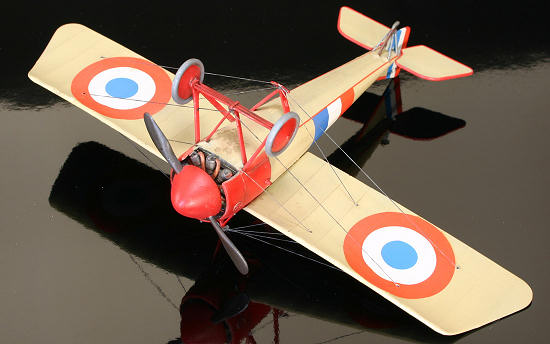 it
appeared in 1916 (according to the instructions). All the photographs I could
find show extremely dark (or possibly black) prop blades, so these were most
probably painted or lacquered. You can spare yourself the wood effect for once.
it
appeared in 1916 (according to the instructions). All the photographs I could
find show extremely dark (or possibly black) prop blades, so these were most
probably painted or lacquered. You can spare yourself the wood effect for once.
Weathering + rigging
The
last steps were to spray a matte coat, add a slight dark wash over the red parts
(I like my WWI planes rather clean), post-shade the fabric-covered surfaces with
pastel powder, gloss-coat the cowling and spinner, and end the project with the
rigging session. After building several
biplanes, I still had to rig a monoplane. As for a change, I had decided to
drill holes in the wings and use rubber thread instead of my usual stretched
sprue, all went rather easily in 30 minutes, the whole rigging being made with a
single length of thread. I know I run the risk of seeing the rubber (in fact
it’s spandex) turn to dust in a few years, but when it happens, replacing it
with a fresh thread won’t be difficult.
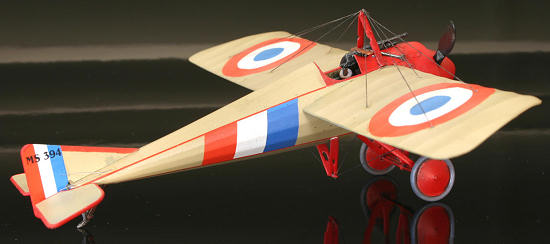 I
hadn’t built a WWI plane for a while, and this one was a great kit for a
“comeback”. In a few, mostly trouble-free hours, you get a nice, colourful
little model of a plane that’s the grand-grandpa of every fighter aircraft, and
that won’t take much room on your shelves, being roughly the size of many WWII
fighters… in 1/72.
I
hadn’t built a WWI plane for a while, and this one was a great kit for a
“comeback”. In a few, mostly trouble-free hours, you get a nice, colourful
little model of a plane that’s the grand-grandpa of every fighter aircraft, and
that won’t take much room on your shelves, being roughly the size of many WWII
fighters… in 1/72.
Recommended
to modellers with some experience, due to the rigging, too-short tailskid struts
and general fragility of the model.
Mach 1 – encyclopédie de l’Aviation,
volume 6, Internet research.
Pierre-André Boillat
April 2010
Copyright ModelingMadness.com. All rights reserved. No
reproduction in part or in whole without express permission from the editor.
If you would like your product reviewed fairly and fairly quickly, please
contact
the editor or see other details in the
Note to
Contributors.
Back to the Main Page
Back to the Review
Index Page 2016


 ial
engine of 110HP for a weight of 510 Kg, which allowed it to reach a top speed of
165 KmH and a maximal altitude of 4’000 M.
ial
engine of 110HP for a weight of 510 Kg, which allowed it to reach a top speed of
165 KmH and a maximal altitude of 4’000 M. This
model from 2004 is the second Morane-Saulnier Type N produced by Eduard. It was
a welcome replacement for the first one, which was one of the brand’s most early
(and rather crude) kits. All photo-etched and white metal parts have been
replaced by (superior) injected ones, the main plastic parts being reworked. Due
to the type’s simple design, there are not many parts, and the kit assembles
rather quickly. Two decal options are provided, for French machines (one with a
black nose that may be
This
model from 2004 is the second Morane-Saulnier Type N produced by Eduard. It was
a welcome replacement for the first one, which was one of the brand’s most early
(and rather crude) kits. All photo-etched and white metal parts have been
replaced by (superior) injected ones, the main plastic parts being reworked. Due
to the type’s simple design, there are not many parts, and the kit assembles
rather quickly. Two decal options are provided, for French machines (one with a
black nose that may be  especially
on the tail planes. After a gloss coat, I added the decals (the red fillets on
the fuselage are a bit tricky to get right) and allowed them to dry for 24
hours. At this moment, I drilled little holes in the wings for the final
rigging.
especially
on the tail planes. After a gloss coat, I added the decals (the red fillets on
the fuselage are a bit tricky to get right) and allowed them to dry for 24
hours. At this moment, I drilled little holes in the wings for the final
rigging.  it
appeared in 1916 (according to the instructions). All the photographs I could
find show extremely dark (or possibly black) prop blades, so these were most
probably painted or lacquered. You can spare yourself the wood effect for once.
it
appeared in 1916 (according to the instructions). All the photographs I could
find show extremely dark (or possibly black) prop blades, so these were most
probably painted or lacquered. You can spare yourself the wood effect for once.